The Cambridge History of Japan, Vol. 4: Early Modern Japan
Подождите немного. Документ загружается.

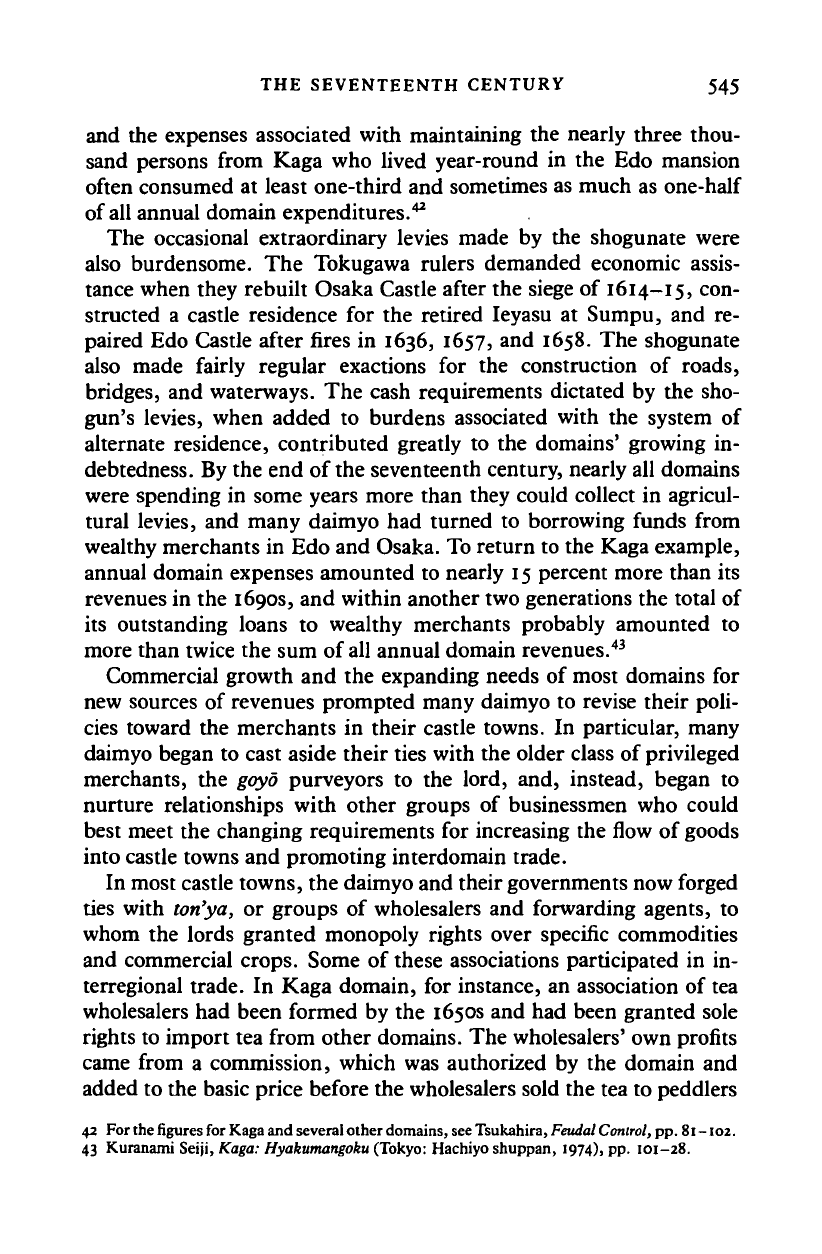
THE SEVENTEENTH CENTURY 545
and the expenses associated with maintaining the nearly three thou-
sand persons from Kaga who lived year-round in the Edo mansion
often consumed at least one-third and sometimes as much as one-half
of
all
annual domain expenditures.
42
The occasional extraordinary levies made by the shogunate were
also burdensome. The Tokugawa rulers demanded economic assis-
tance when they rebuilt Osaka Castle after the siege of 1614-15, con-
structed a castle residence for the retired Ieyasu at Sumpu, and re-
paired Edo Castle after fires in 1636, 1657, and 1658. The shogunate
also made fairly regular exactions for the construction of roads,
bridges, and waterways. The cash requirements dictated by the sho-
gun's levies, when added to burdens associated with the system of
alternate residence, contributed greatly to the domains' growing in-
debtedness. By the end of the seventeenth century, nearly all domains
were spending in some years more than they could collect in agricul-
tural levies, and many daimyo had turned to borrowing funds from
wealthy merchants in Edo and Osaka. To return to the Kaga example,
annual domain expenses amounted to nearly 15 percent more than its
revenues in the 1690s, and within another two generations the total of
its outstanding loans to wealthy merchants probably amounted to
more than twice the sum of
all
annual domain revenues.
43
Commercial growth and the expanding needs of most domains for
new sources of revenues prompted many daimyo to revise their poli-
cies toward the merchants in their castle towns. In particular, many
daimyo began to cast aside their ties with the older class of privileged
merchants, the goyo purveyors to the lord, and, instead, began to
nurture relationships with other groups of businessmen who could
best meet the changing requirements for increasing the flow of goods
into castle towns and promoting interdomain trade.
In most castle towns, the daimyo and their governments now forged
ties with ton'ya, or groups of wholesalers and forwarding agents, to
whom the lords granted monopoly rights over specific commodities
and commercial crops. Some of these associations participated in in-
terregional trade. In Kaga domain, for instance, an association of tea
wholesalers had been formed by the 1650s and had been granted sole
rights to import tea from other domains. The wholesalers' own profits
came from a commission, which was authorized by the domain and
added to the basic price before the wholesalers sold the tea to peddlers
42 For the figures for Kaga and several other domains, see Tsukahira,
Feudal
Control,
pp.
81
-102.
43 Kuranami Seiji, Kaga: Hyakumangoku (Tokyo: Hachiyo shuppan, 1974), pp. 101-28.
Cambridge Histories Online © Cambridge University Press, 2008
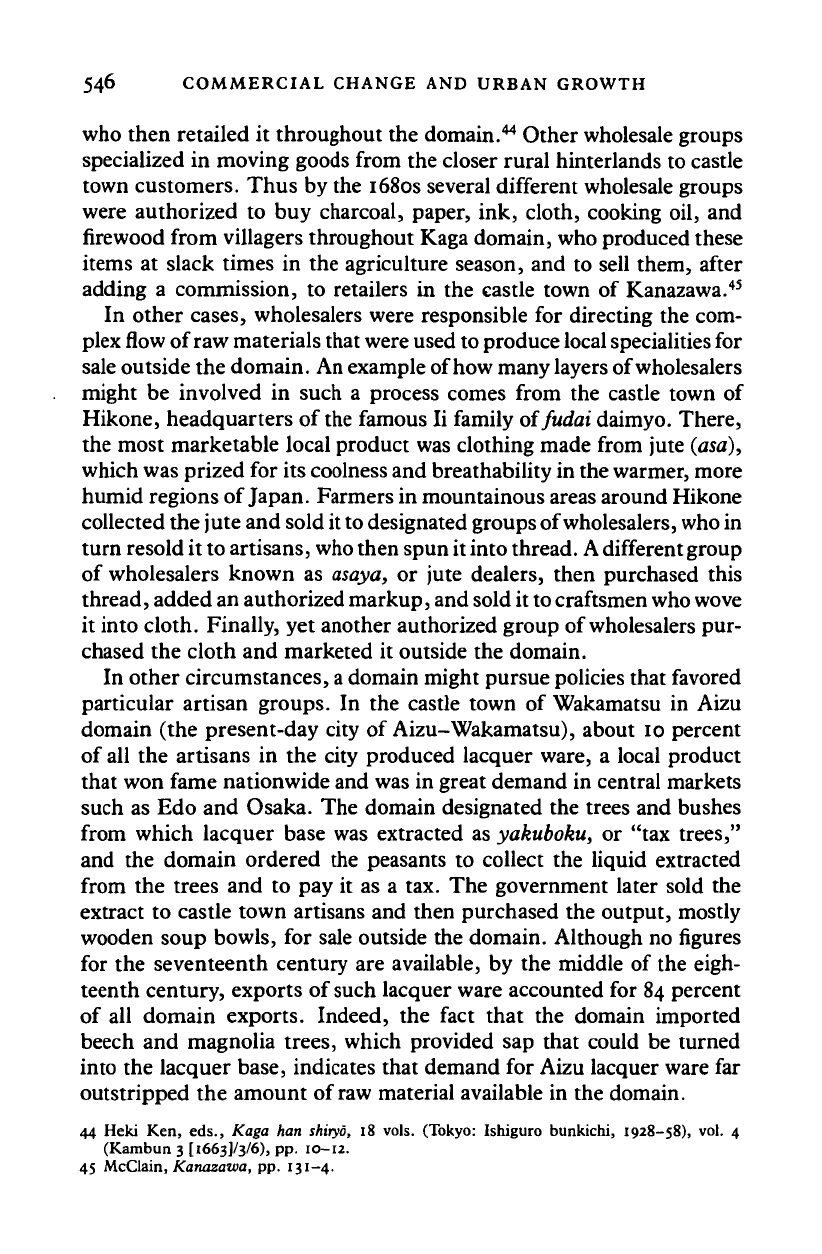
546 COMMERCIAL CHANGE AND URBAN GROWTH
who then retailed it throughout the domain.
44
Other wholesale groups
specialized in moving goods from the closer rural hinterlands to castle
town customers. Thus by the 1680s several different wholesale groups
were authorized to buy charcoal, paper, ink, cloth, cooking oil, and
firewood from villagers throughout Kaga domain, who produced these
items at slack times in the agriculture season, and to sell them, after
adding a commission, to retailers in the castle town of Kanazawa.
45
In other cases, wholesalers were responsible for directing the com-
plex
flow
of raw materials that were used
to
produce local specialities for
sale outside the domain. An example of how many layers of wholesalers
might be involved in such a process comes from the castle town of
Hikone, headquarters of the famous Ii family of fudai daimyo. There,
the most marketable local product was clothing made from jute (asa),
which was prized for its coolness and breathability in the warmer, more
humid regions of Japan. Farmers in mountainous areas around Hikone
collected the jute and sold
it to
designated groups of wholesalers,
who
in
turn resold it to artisans,
who
then spun it into thread.
A
different group
of wholesalers known as
asaya,
or jute dealers, then purchased this
thread, added an authorized markup, and sold it
to
craftsmen
who wove
it into cloth. Finally, yet another authorized group of wholesalers pur-
chased the cloth and marketed it outside the domain.
In other circumstances,
a
domain might pursue policies that favored
particular artisan groups. In the castle town of Wakamatsu in Aizu
domain (the present-day city of Aizu-Wakamatsu), about 10 percent
of all the artisans in the city produced lacquer ware, a local product
that won fame nationwide and was in great demand in central markets
such as Edo and Osaka. The domain designated the trees and bushes
from which lacquer base was extracted as yakuboku, or "tax trees,"
and the domain ordered the peasants to collect the liquid extracted
from the trees and to pay it as a tax. The government later sold the
extract to castle town artisans and then purchased the output, mostly
wooden soup bowls, for sale outside the domain. Although no figures
for the seventeenth century are available, by the middle of the eigh-
teenth century, exports of such lacquer ware accounted for 84 percent
of all domain exports. Indeed, the fact that the domain imported
beech and magnolia trees, which provided sap that could be turned
into the lacquer base, indicates that demand for Aizu lacquer ware far
outstripped the amount of raw material available in the domain.
44 Heki Ken, eds., Kaga han shiryo, 18 vols. (Tokyo: Ishiguro bunkichi, 1928-58), vol. 4
(Kambun 3 [i663]/3/6), pp. 10-12.
45 McClain, Kanazawa, pp. 131-4.
Cambridge Histories Online © Cambridge University Press, 2008
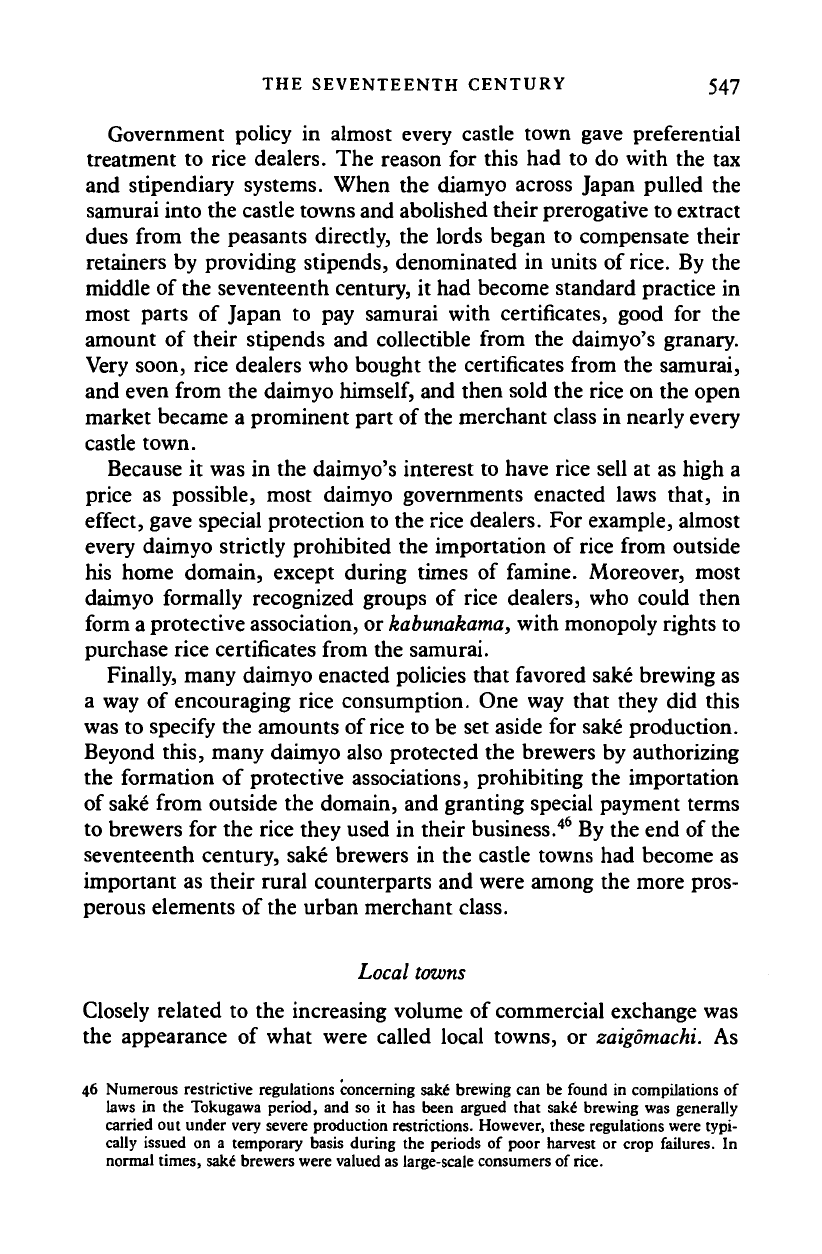
THE SEVENTEENTH CENTURY 547
Government policy in almost every castle town gave preferential
treatment to rice dealers. The reason for this had to do with the tax
and stipendiary systems. When the diamyo across Japan pulled the
samurai into the castle towns and abolished their prerogative to extract
dues from the peasants directly, the lords began to compensate their
retainers by providing stipends, denominated in units of rice. By the
middle of the seventeenth century, it had become standard practice in
most parts of Japan to pay samurai with certificates, good for the
amount of their stipends and collectible from the daimyo's granary.
Very soon, rice dealers who bought the certificates from the samurai,
and even from the daimyo
himself,
and then sold the rice on the open
market became a prominent part of the merchant class in nearly every
castle town.
Because it was in the daimyo's interest to have rice sell at as high a
price as possible, most daimyo governments enacted laws that, in
effect, gave special protection to the rice dealers. For example, almost
every daimyo strictly prohibited the importation of rice from outside
his home domain, except during times of famine. Moreover, most
daimyo formally recognized groups of rice dealers, who could then
form a protective association, or kabunakama, with monopoly rights to
purchase rice certificates from the samurai.
Finally, many daimyo enacted policies that favored sake brewing as
a way of encouraging rice consumption. One way that they did this
was to specify the amounts of rice to be set aside for sake production.
Beyond this, many daimyo also protected the brewers by authorizing
the formation of protective associations, prohibiting the importation
of sake from outside the domain, and granting special payment terms
to brewers for the rice they used in their business.
46
By the end of the
seventeenth century, sake brewers in the castle towns had become as
important as their rural counterparts and were among the more pros-
perous elements of the urban merchant class.
Local towns
Closely related to the increasing volume of commercial exchange was
the appearance of what were called local towns, or
zaigomachi.
As
46 Numerous restrictive regulations concerning sake brewing
can be
found
in
compilations
of
laws
in the
Tokugawa period,
and so it has
been argued that sak6 brewing
was
generally
carried
out
under very severe production restrictions. However, these regulations were typi-
cally issued
on a
temporary basis during
the
periods
of
poor harvest
or
crop failures.
In
normal times, sake brewers were valued as large-scale consumers
of
rice.
Cambridge Histories Online © Cambridge University Press, 2008
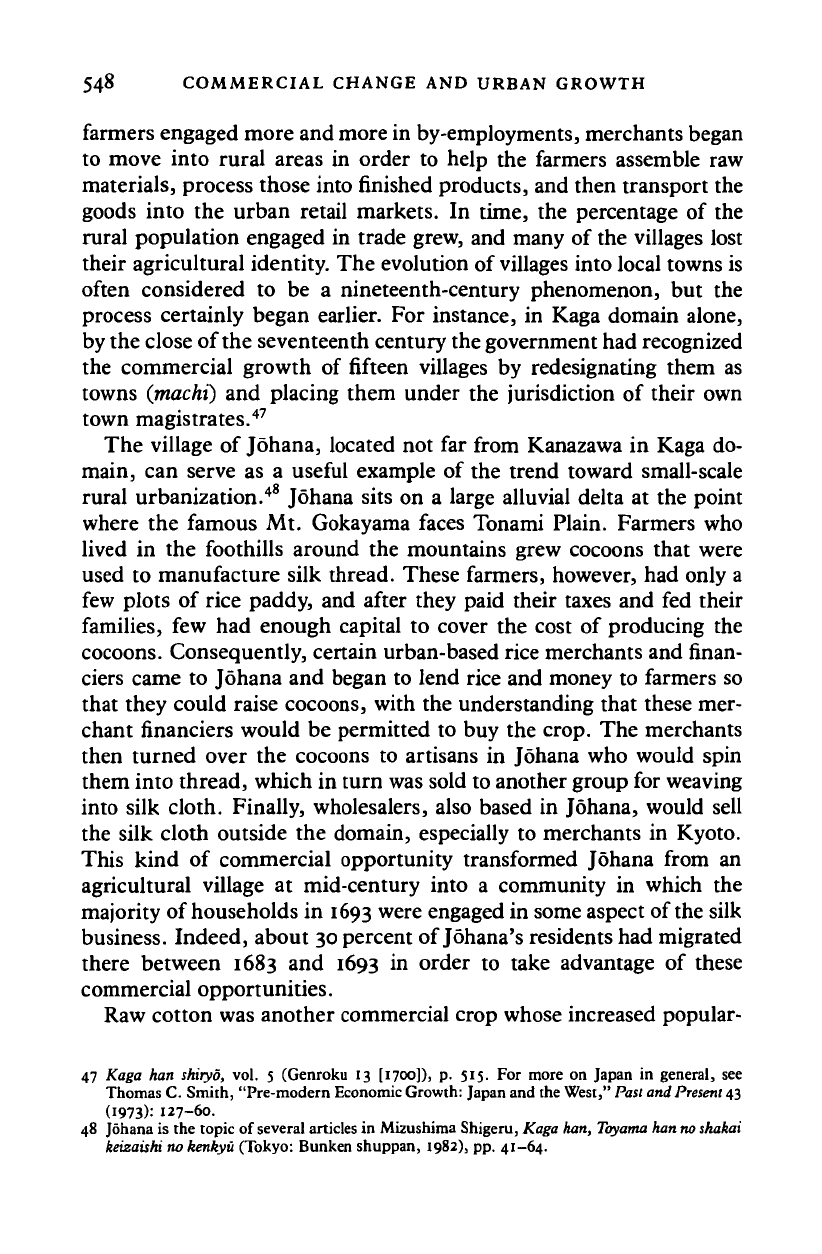
548 COMMERCIAL CHANGE AND URBAN GROWTH
farmers engaged more and more in by-employments, merchants began
to move into rural areas
in
order
to
help the farmers assemble raw
materials, process those into finished products, and then transport the
goods into the urban retail markets.
In
time, the percentage
of
the
rural population engaged in trade grew, and many of the villages lost
their agricultural identity. The evolution of villages into local towns is
often considered
to be a
nineteenth-century phenomenon,
but the
process certainly began earlier. For instance,
in
Kaga domain alone,
by the close of the seventeenth century the government had recognized
the commercial growth
of
fifteen villages
by
redesignating them
as
towns (machi) and placing them under the jurisdiction
of
their own
town magistrates.
47
The village of Johana, located not far from Kanazawa in Kaga do-
main, can serve as
a
useful example
of
the trend toward small-scale
rural urbanization.
48
Johana sits on
a
large alluvial delta
at
the point
where the famous Mt. Gokayama faces Tonami Plain. Farmers who
lived
in
the foothills around the mountains grew cocoons that were
used to manufacture silk thread. These farmers, however, had only a
few plots of rice paddy, and after they paid their taxes and fed their
families, few had enough capital
to
cover the cost
of
producing the
cocoons. Consequently, certain urban-based rice merchants and finan-
ciers came to Johana and began to lend rice and money to farmers so
that they could raise cocoons, with the understanding that these mer-
chant financiers would be permitted to buy the crop. The merchants
then turned over the cocoons to artisans
in
Johana who would spin
them into thread, which in turn was sold to another group for weaving
into silk cloth. Finally, wholesalers, also based in Johana, would sell
the silk cloth outside the domain, especially to merchants
in
Kyoto.
This kind
of
commercial opportunity transformed Johana from
an
agricultural village
at
mid-century into
a
community
in
which
the
majority of households in 1693 were engaged in some aspect of
the
silk
business. Indeed, about 30 percent of Johana's residents had migrated
there between 1683
and
1693
in
order
to
take advantage
of
these
commercial opportunities.
Raw cotton was another commercial crop whose increased popular-
47 Kaga han shiryo, vol.
5
(Genroku
13
[1700]),
p.
515. For more
on
Japan
in
general,
see
Thomas C. Smith, "Pre-modern Economic Growth: Japan and the West," Past and
Present
43
(1973): 127-60.
48 Johana is the topic of several articles in Mizushima Shigeru, Kaga han,
Toyama
han
no shakai
keizaishi no kenkyu (Tokyo: Bunken shuppan, 1982), pp. 41-64.
Cambridge Histories Online © Cambridge University Press, 2008
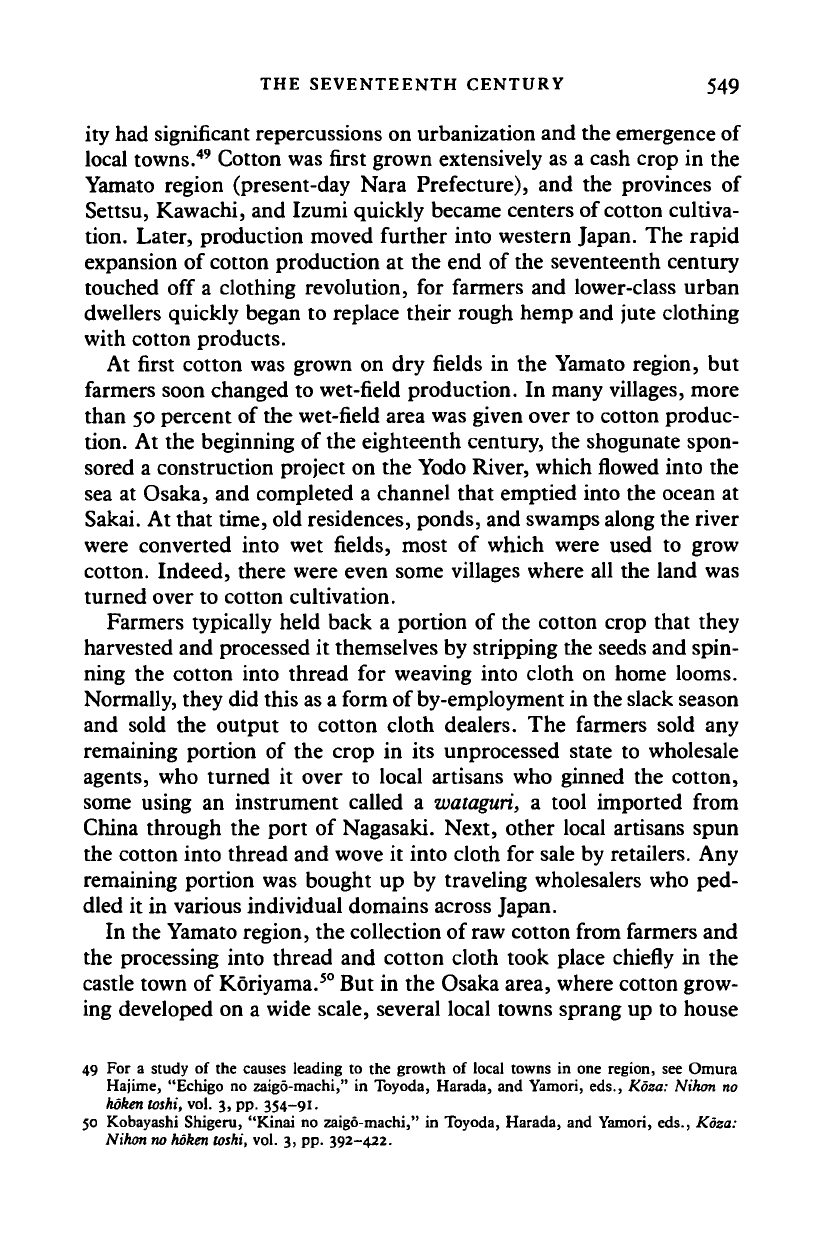
THE SEVENTEENTH CENTURY 549
ity had significant repercussions on urbanization and the emergence of
local towns.
49
Cotton was first grown extensively as a cash crop in the
Yamato region (present-day Nara Prefecture), and the provinces of
Settsu, Kawachi, and Izumi quickly became centers of cotton cultiva-
tion. Later, production moved further into western Japan. The rapid
expansion of cotton production at the end of the seventeenth century
touched off a clothing revolution, for farmers and lower-class urban
dwellers quickly began to replace their rough hemp and jute clothing
with cotton products.
At first cotton was grown on dry fields in the Yamato region, but
farmers soon changed to wet-field production. In many villages, more
than 50 percent of the wet-field area was given over to cotton produc-
tion. At the beginning of the eighteenth century, the shogunate spon-
sored a construction project on the Yodo River, which flowed into the
sea at Osaka, and completed a channel that emptied into the ocean at
Sakai. At that time, old residences, ponds, and swamps along the river
were converted into wet fields, most of which were used to grow
cotton. Indeed, there were even some villages where all the land was
turned over to cotton cultivation.
Farmers typically held back a portion of the cotton crop that they
harvested and processed it themselves by stripping the seeds and spin-
ning the cotton into thread for weaving into cloth on home looms.
Normally, they did this as a form of by-employment in the slack season
and sold the output to cotton cloth dealers. The farmers sold any
remaining portion of the crop in its unprocessed state to wholesale
agents, who turned it over to local artisans who ginned the cotton,
some using an instrument called a
wataguri,
a tool imported from
China through the port of Nagasaki. Next, other local artisans spun
the cotton into thread and wove it into cloth for sale by retailers. Any
remaining portion was bought up by traveling wholesalers who ped-
dled it in various individual domains across Japan.
In the Yamato region, the collection of
raw
cotton from farmers and
the processing into thread and cotton cloth took place chiefly in the
castle town of Koriyama.
50
But in the Osaka area, where cotton grow-
ing developed on a wide scale, several local towns sprang up to house
49 For a study of the causes leading to the growth of local towns in one region, see Omura
Hajime, "Echigo no zaigo-machi," in Toyoda, Harada, and Yamori, eds., Koza: Nihon no
hoken
toshi, vol. 3, pp. 354-91.
50 Kobayashi Shigeru, "Kinai no zaigo-machi," in Toyoda, Harada, and Yamori, eds., Koza:
Nihon no
hoken
toshi, vol. 3, pp. 392-422.
Cambridge Histories Online © Cambridge University Press, 2008
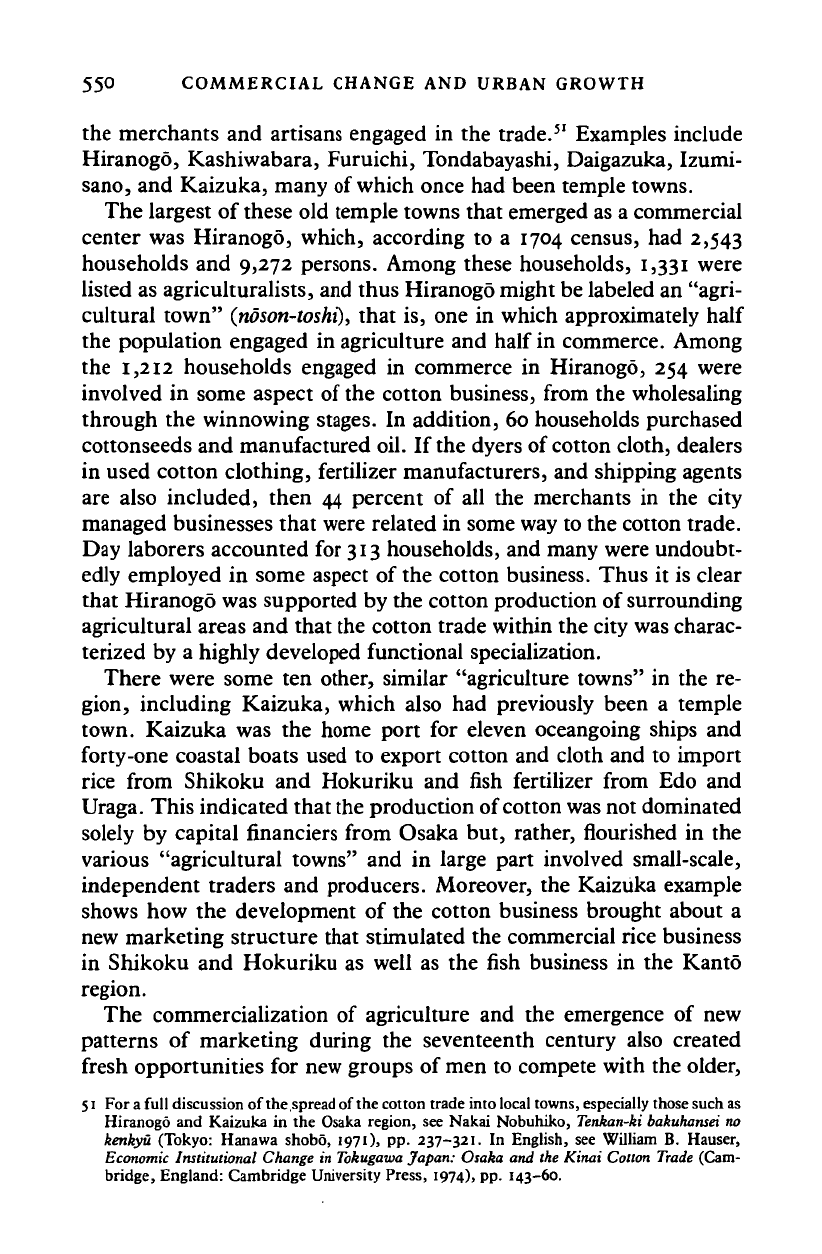
550 COMMERCIAL CHANGE AND URBAN GROWTH
the merchants and artisans engaged in the trade.
51
Examples include
Hiranogo, Kashiwabara, Furuichi, Tondabayashi, Daigazuka, Izumi-
sano,
and Kaizuka, many of which once had been temple towns.
The largest of these old temple towns that emerged as a commercial
center was Hiranogo, which, according to a 1704 census, had 2,543
households and 9,272 persons. Among these households, 1,331 were
listed as agriculturalists, and thus Hiranogo might be labeled an "agri-
cultural town"
(noson-toshi),
that is, one in which approximately half
the population engaged in agriculture and half in commerce. Among
the 1,212 households engaged in commerce in Hiranogo, 254 were
involved in some aspect of the cotton business, from the wholesaling
through the winnowing stages. In addition, 60 households purchased
cottonseeds and manufactured oil. If the dyers of cotton cloth, dealers
in used cotton clothing, fertilizer manufacturers, and shipping agents
are also included, then 44 percent of all the merchants in the city
managed businesses that were related in some way to the cotton trade.
Day laborers accounted for 313 households, and many were undoubt-
edly employed in some aspect of the cotton business. Thus it is clear
that Hiranogo was supported by the cotton production of surrounding
agricultural areas and that the cotton trade within the city was charac-
terized by a highly developed functional specialization.
There were some ten other, similar "agriculture towns" in the re-
gion, including Kaizuka, which also had previously been a temple
town. Kaizuka was the home port for eleven oceangoing ships and
forty-one coastal boats used to export cotton and cloth and to import
rice from Shikoku and Hokuriku and fish fertilizer from Edo and
Uraga. This indicated that the production of cotton was not dominated
solely by capital financiers from Osaka but, rather, flourished in the
various "agricultural towns" and in large part involved small-scale,
independent traders and producers. Moreover, the Kaizuka example
shows how the development of the cotton business brought about a
new marketing structure that stimulated the commercial rice business
in Shikoku and Hokuriku as well as the fish business in the Kanto
region.
The commercialization of agriculture and the emergence of new
patterns of marketing during the seventeenth century also created
fresh opportunities for new groups of men to compete with the older,
51 For a full discussion of the spread of the cotton trade into local towns, especially those such as
Hiranogo and Kaizuka in the Osaka region, see Nakai Nobuhiko,
Tenkan-ki bakuhansei
no
kenkyu (Tokyo: Hanawa shobo, 1971), pp. 237-321. In English, see William B. Hauser,
Economic Institutional Change in
Tokugawa
Japan: Osaka and the Kinai Cotton Trade (Cam-
bridge, England: Cambridge University Press, 1974), pp. 143-60.
Cambridge Histories Online © Cambridge University Press, 2008
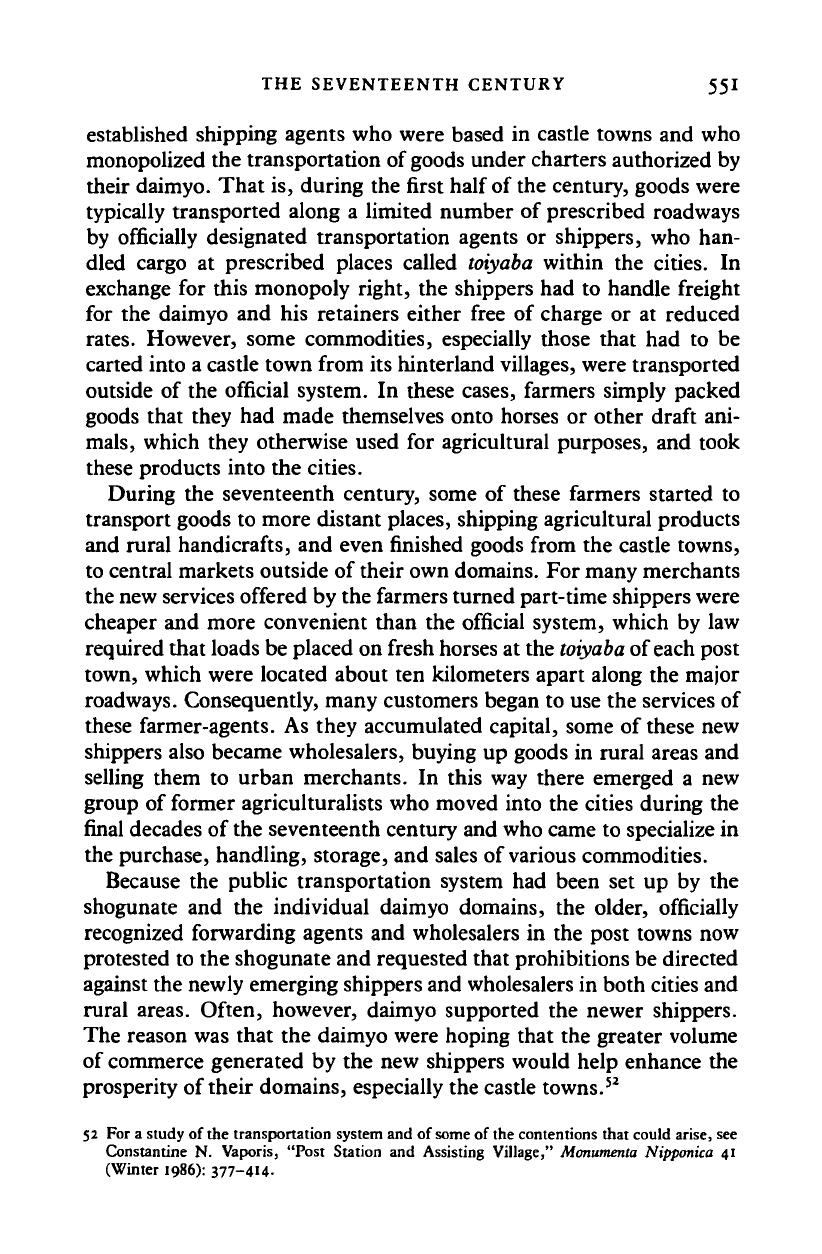
THE SEVENTEENTH CENTURY 551
established shipping agents who were based in castle towns and who
monopolized the transportation of goods under charters authorized by
their daimyo. That is, during the first half of the century, goods were
typically transported along a limited number of prescribed roadways
by officially designated transportation agents or shippers, who han-
dled cargo at prescribed places called
toiyaba
within the cities. In
exchange for this monopoly right, the shippers had to handle freight
for the daimyo and his retainers either free of charge or at reduced
rates.
However, some commodities, especially those that had to be
carted into a castle town from its hinterland villages, were transported
outside of the official system. In these cases, farmers simply packed
goods that they had made themselves onto horses or other draft ani-
mals,
which they otherwise used for agricultural purposes, and took
these products into the cities.
During the seventeenth century, some of these farmers started to
transport goods to more distant places, shipping agricultural products
and rural handicrafts, and even finished goods from the castle towns,
to central markets outside of their own domains. For many merchants
the new services offered by the farmers turned part-time shippers were
cheaper and more convenient than the official system, which by law
required that loads be placed on fresh horses at the
toiyaba
of each post
town, which were located about ten kilometers apart along the major
roadways. Consequently, many customers began to use the services of
these farmer-agents. As they accumulated capital, some of these new
shippers also became wholesalers, buying up goods in rural areas and
selling them to urban merchants. In this way there emerged a new
group of former agriculturalists who moved into the cities during the
final decades of the seventeenth century and who came to specialize in
the purchase, handling, storage, and sales of various commodities.
Because the public transportation system had been set up by the
shogunate and the individual daimyo domains, the older, officially
recognized forwarding agents and wholesalers in the post towns now
protested to the shogunate and requested that prohibitions be directed
against the newly emerging shippers and wholesalers in both cities and
rural areas. Often, however, daimyo supported the newer shippers.
The reason was that the daimyo were hoping that the greater volume
of commerce generated by the new shippers would help enhance the
prosperity of their domains, especially the castle towns.
52
52 For a study of the transportation system and of some of the contentions that could arise, see
Constantine N. Vaporis, "Post Station and Assisting Village," Monumenta Nipponica 41
(Winter 1986): 377-414.
Cambridge Histories Online © Cambridge University Press, 2008
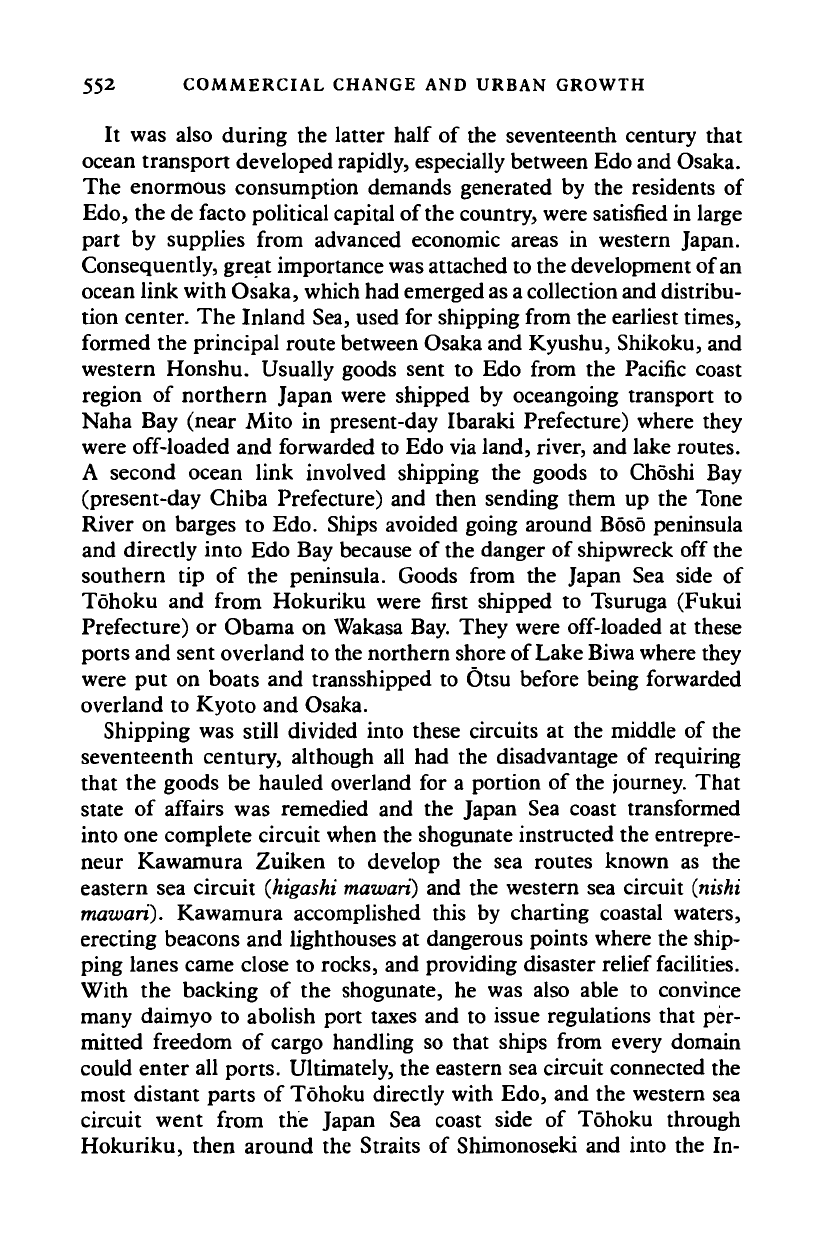
552 COMMERCIAL CHANGE AND URBAN GROWTH
It was also during the latter half of the seventeenth century that
ocean transport developed rapidly, especially between Edo and Osaka.
The enormous consumption demands generated by the residents of
Edo,
the de facto political capital of the country, were satisfied in large
part by supplies from advanced economic areas in western Japan.
Consequently, great importance was attached to the development of an
ocean link with Osaka, which had emerged as
a
collection and distribu-
tion center. The Inland Sea, used for shipping from the earliest times,
formed the principal route between Osaka and Kyushu, Shikoku, and
western Honshu. Usually goods sent to Edo from the Pacific coast
region of northern Japan were shipped by oceangoing transport to
Naha Bay (near Mito in present-day Ibaraki Prefecture) where they
were off-loaded and forwarded to Edo via land, river, and lake routes.
A second ocean link involved shipping the goods to Choshi Bay
(present-day Chiba Prefecture) and then sending them up the Tone
River on barges to Edo. Ships avoided going around Boso peninsula
and directly into Edo Bay because of the danger of shipwreck off the
southern tip of the peninsula. Goods from the Japan Sea side of
Tohoku and from Hokuriku were first shipped to Tsuruga (Fukui
Prefecture) or Obama on Wakasa Bay. They were off-loaded at these
ports and sent overland to the northern shore of Lake Biwa where they
were put on boats and transshipped to Otsu before being forwarded
overland to Kyoto and Osaka.
Shipping was still divided into these circuits at the middle of the
seventeenth century, although all had the disadvantage of requiring
that the goods be hauled overland for a portion of the journey. That
state of affairs was remedied and the Japan Sea coast transformed
into one complete circuit when the shogunate instructed the entrepre-
neur Kawamura Zuiken to develop the sea routes known as the
eastern sea circuit
(higashi mawari)
and the western sea circuit
(nishi
mawari).
Kawamura accomplished this by charting coastal waters,
erecting beacons and lighthouses at dangerous points where the ship-
ping lanes came close to rocks, and providing disaster relief facilities.
With the backing of the shogunate, he was also able to convince
many daimyo to abolish port taxes and to issue regulations that per-
mitted freedom of cargo handling so that ships from every domain
could enter all ports. Ultimately, the eastern sea circuit connected the
most distant parts of Tohoku directly with Edo, and the western sea
circuit went from the Japan Sea coast side of Tohoku through
Hokuriku, then around the Straits of Shimonoseki and into the In-
Cambridge Histories Online © Cambridge University Press, 2008

THE SEVENTEENTH CENTURY 553
land Sea, before continuing directly to Osaka. The Edo-Osaka route
connected the two circuits.
53
The establishment of the two coastal shipping circuits in 1671 and
1672 was a direct response to the growth of Edo's population. In other
words, Edo's demands for foodstuffs, which had increased markedly
just before this period, far outstripped supplies from the city's nearby
hinterland, which were unusually scarce because of several poor har-
vests,
and this threatened social unrest in the city. Consequently, the
shogunate was anxious to find a way to ship tax rice from its holdings
in the Tohoku area quickly and safely to Edo.
The consolidation of the shipping circuits, however, also encour-
aged private traders and stimulated the development of
a
nationwide
commercial economy by fostering the manufacture of goods for export
outside the area of production. One example of this is commercial
fertilizers which became necessary for the cultivation of raw cotton as
the acreage dedicated to that crop expanded explosively in the Nara
and Osaka areas. The most common kind of fertilizer was made from
dried sardines, and at first fish taken from the Inland Sea were used
for this purpose. In response to the rapid increase in demand for this
kind of commercial fertilizer, new businesses were established on Boso
peninsula, especially at Kujukuri beach. At first, the fishing grounds
around Boso were worked by
fishermen
who came up from Wakayama
during the fishing season and toiled for a daily wage on boats owned
and managed by men who lived in the Kujukuri area. They dried the
sardines on the sands of the beach and then sent them to ports in
Uraga. Fertilizer merchants from Kansai opened branch stores in the
port towns around Uraga Bay to buy up fertilizer for shipment to
cotton-growing areas in western Japan.
54
Until this time, the broad sands of Kujukuri beach had been used to
produce modest amounts of salt, which the local farmers made by
boiling off salt water in large cauldrons. Now, however, the farmers
learned from the men of Wakayama new methods of netting fish. In
time,
some of
the
villagers even abandoned their agricultural homes in
53 For a thorough study in English, see E. Sydney Crawcour, "Kawamura Zuiken: A Seven-
teenth Century Entrepreneur,"
Transactions
of
the
Asiatic Society of Japan 9, 3rd series (1966):
1-23. A detailed analysis of the impact of the new routes on local commerce is contained in
Takase Tamotsu, Kaga han
kaiunshi no kenkyu
(Tokyo: Yuhikaku, 1979).
54 For an account of how the development of shipping routes influenced commercial production
on the opposite side of Japan, see Makino Ryushin, Kilamaebune nojidai
(Tokyo:
Kyoikusha,
1979)-
In English, see Robert G. Flershem, "Some Aspects of Japan Sea Trade in the
Tokugawa
Period,"
Journal
of Asian Studies 23 (May 1964): 405-16.
Cambridge Histories Online © Cambridge University Press, 2008
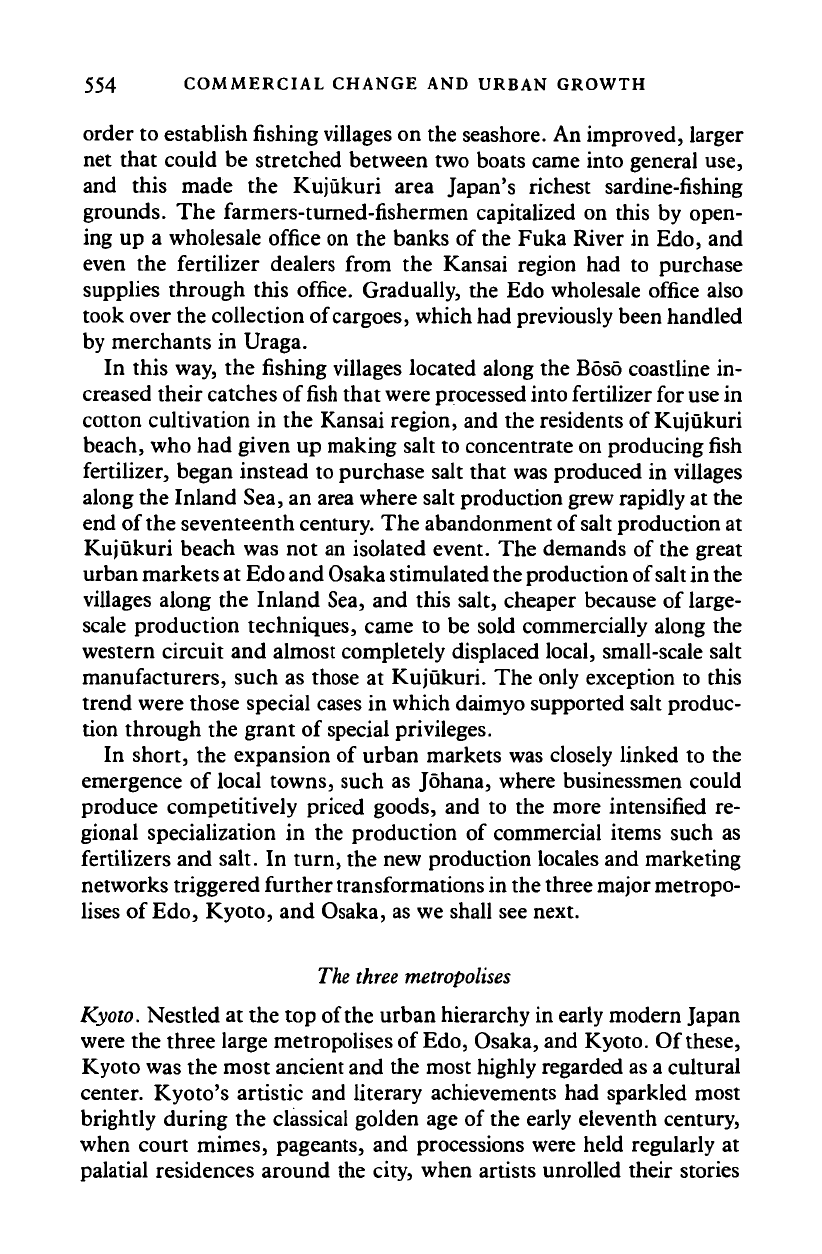
554 COMMERCIAL CHANGE AND URBAN GROWTH
order to establish fishing villages on the seashore. An improved, larger
net that could be stretched between two boats came into general use,
and this made the Kujukuri area Japan's richest sardine-fishing
grounds. The farmers-turned-fishermen capitalized on this by open-
ing up a wholesale office on the banks of the Fuka River in Edo, and
even the fertilizer dealers from the Kansai region had to purchase
supplies through this office. Gradually, the Edo wholesale office also
took over the collection of cargoes, which had previously been handled
by merchants in Uraga.
In this way, the fishing villages located along the Boso coastline in-
creased their catches offish that were processed into fertilizer for use in
cotton cultivation in the Kansai region, and the residents of Kujukuri
beach, who had given up making salt to concentrate on producing fish
fertilizer, began instead to purchase salt that was produced in villages
along the Inland Sea, an area where salt production grew rapidly at the
end of the seventeenth century. The abandonment of salt production at
Kujukuri beach was not an isolated event. The demands of the great
urban markets at Edo and Osaka stimulated the production of salt in the
villages along the Inland Sea, and this salt, cheaper because of large-
scale production techniques, came to be sold commercially along the
western circuit and almost completely displaced local, small-scale salt
manufacturers, such as those at Kujukuri. The only exception to this
trend were those special cases in which daimyo supported salt produc-
tion through the grant of special privileges.
In short, the expansion of urban markets was closely linked to the
emergence of local towns, such as Johana, where businessmen could
produce competitively priced goods, and to the more intensified re-
gional specialization in the production of commercial items such as
fertilizers and salt. In turn, the new production locales and marketing
networks triggered further transformations in the three major metropo-
lises of Edo, Kyoto, and Osaka, as we shall see next.
The three
metropolises
Kyoto.
Nestled at the top of the urban hierarchy in early modern Japan
were the three large metropolises of
Edo,
Osaka, and Kyoto. Of these,
Kyoto was the most ancient and the most highly regarded as a cultural
center. Kyoto's artistic and literary achievements had sparkled most
brightly during the classical golden age of the early eleventh century,
when court mimes, pageants, and processions were held regularly at
palatial residences around the city, when artists unrolled their stories
Cambridge Histories Online © Cambridge University Press, 2008
